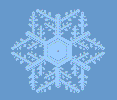

The Superconducting Gravity Gradiometer (SGG is an instrument designed to study the way Earth's gravitational field varies from place to place. Professor Ho Jung Paik of the University of Maryland worked with the Goddard Cryogenics Branch to develop the instrument. Although we have proposed it, we have so far not been able to find any funding to fly it. If funding ever became available, we feel that the Superconducting Gravity Gradiometer would still be a useful instrument. It was designed to be usable either as a Shuttle payload (which is no longer a possibility) or as a free-flyer.
The SGG consists of three orthogonal pairs of linear accelerometers capable of simultaneously measuring linear accelerations and the gradient in the gravitational potential in all three axes. Each linear accelerometer is comprised of a 1 kilogram proof mass suspended within a housing by means of very weak cantilever springs. All components are high purity niobium. Superconducting pancake coils are located close to the proof masses. Due to the Meissner effect, the self inductances of these coils depend on their distance to the proof mass surface. Motion of the proof masses is detected through the associated change in a persistent current stored in the superconducting coils (the current "persists" because the coil is a closed loop of superconductor and, therefore, there is no resistance in the loop). There will be two coil circuits associated with each proof mass pair, each with a dc Superconducting QUantum Interference Device(SQUID) to monitor changes in the persistent current in the circuit. The circuits will be configured in such a way that the output of one SQUID responds to common mode motion of the paired masses, while the other responds only to relative displacements. In response to linear accelerations, the paired proof masses will move in unison (common mode) while in response to a change in the local gravity gradient there will be a relative displacement of the paired proof masses. Thus, one circiut detects linear motion while the other circiut detects the local gravity gradient.
An equivalent gravity gradient noise of 0.02 Eotvos Hz -1/2 has been demonstrated for a prototype instrument in the laboratory. Although this noise level is more than an order of magnitude lower than that of other gradiometers, it falls short of the intrinsic noise level of 10-3 Eotvos Hz-1/2 A severe limitation of the ground laboratory is the presence of the earth's large gravitational acceleration, which couples to the gradient outputs through various mechanical errors. On orbit, mechanical imperfections and misalignments in the instrument will also allow linear and angular accelerations (steady state and jitter) of the spacecraft to couple into the output. In addition, the SGG will be sensitive to such disturbances as thermal fluctuations of the helium bath, liquid helium motion and boiloff, and particle heating. The most significant error source, however, is the centrifugal acceleration associated with rotational motion of the instrument in an earth-pointing attitude. Most errors are controlled or by careful design and alignment of the instrument or removed by measuring the disturbance. For example, false gravity signals due to linear accelerations are removed by precisely measuring spacecraft motion and the error coefficient which is the ratio of the gradiometer response to a known (deliberate) linear acceleration. The remaining errors are minimized by proper design of the dewar and spacecraft, and by a sophisticated attitude control system.
For more information about SGG, contact the following individuals:
Return links:
 Cryogenics & Fluids Home Page
Cryogenics & Fluids Home Page
|

|